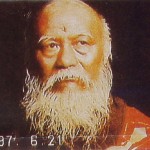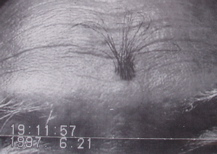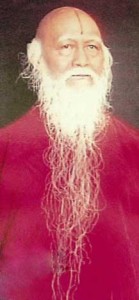It is said “on the load to Linqui, a passenger from Hogdu can heal deceased souls with his spiritual power.” This tale has been handed down for thousands of years. Yet very few people have ever witnessed it with their own eyes. Fortunately, the author has become one of the very few.
April in Linqui is the season when grass sprouts and fireflies flit. In an early morning, accompanied by our friend Guanxiu, a monk, we set off our expedition with food and light camping equipment. In spite of the fact that I had not traveled on foot for a long time, and was use to traveling by car, I was refreshed by the scent of flowers, chiming of birds, and the flowing brooks, and thus forgot fatigue. Guanxiu, with his familiarity with the area, let us walk in the wilderness, picking his way through the seemingly impassable forest and bringing us to new sites now and then. We walked in this fashion during the day, and in the evening, we set up camp on the ground to sleep. At noon of the third day, we finally reached “a thread of sky.”
Mysterious and enchanting, this “a thread of sky” can be described as a masterpiece of nature. Two sheer cliffs, facing each other, tower to the sky with immeasurable height. The ridges are so steep, it is as if they were cut deliberately. There are no trees except some vines growing attached to the surface of the ridges. The sunlight in the middle of the day pours down through the narrow ravine which is barely two feet wide which gives travelers a little bit of relief in such a perilous atmosphere. While my mind was wondering, Guanxiu said something loudly which I could not understand. Shortly thereafter, a chant of “Amitabha Buddha” was heard. Looking up I saw a spot in the middle of the mountain ridge where vines were poked apart, and from that opening a hanging ladder made of vine descended slowly. A monk came down with the ladder. “This is Guanxin, the servant of the Master,” Guanxiu introduced him to me. I presented my name card hastily to Guanxin. But he waved his hand and said, “You didn’t come at a right time and may not be able to meet the Master.” “Then, how about tomorrow?” I asked eagerly. “It’s difficult to tell. The Master has been in meditation for two days already. He usually remains in meditation for a half or even one month.” Noticing my anxiousness, Guanxiu tried to comfort me by saying, “Whatever is going to happen, let up go up to pay respect to the Master.”
We climbed up the ladder and at its end entered into a cave whose space was about twenty square meters. In the middle of the cave, an old man sat cross-legged, motionlessly like a rock. His face was elegant with a long and beautiful beard. He looked more dignified than Damuo (Patriarch Bodhidharma), the Master of Zen, as portrayed in a movie. I took out my camera and began to take pictures. Seeing this, Guanxiu stopped me immediately and pushed me to pay respect to the Master. As soon as we knelt down, a voice sounding like a bell echoed to my ears, “Get up quickly. You have walked for three days. Your right shoe was broken and your toe is bleeding.” Hearing the voice, I was shocked, partly because the voice was so loud, and partly because on the afternoon of the first day of our journey my right foot hit a rock which cut a long cut in the sole and wounded by toe. It had started bleeding and was still painful at this moment. I could not imagine how this Master can point out my problems immediately. I raised my head to him. Looking at my amazement, the Master smiled and said, “It’s all right. You will be fine soon.” And then he asked us to sit on the chairs.
The chair was so old that sitting on it I began to worry that it might collapse. Looking around I noticed that the furnishings in the cave were very simple, yet very clean. A stone table and four stone stools shined like mirrors. The stool on which the Master sat was a little bit larger with a straw cushion laid on the top. There was no bed, nor what we city folks call “furniture.” In a stone niche were a couple of bowls, and at the entrance of the cave there was a wok supported by three rocks. A teapot, which could have been several decades old, was placed on the stone table. There was nothing else in the cave.
Guanxiu was a student of the Master. I could not quite understand their conversation, and thus felt that I was not in the position to join the conversation but should listen quietly while watching carefully. I was told that the Master’s name was Lao Na Monk. For many years he had practiced the Buddha-dharma and attained the inner power of Vajra (Jin Gang). He never slept during the year. Although 89 years old, his voice was strong and clear, and his bearing and demeanor possessed more vitality than a middle aged person. More amazing was that a tuft of hair which was a mixture of black and white grew on his forehead between his two eyebrows, curling upward, about one inch long. I noticed that during his conversation with Guanxiu the hair flashed three times. Unable to resist my curiosity, I started asking questions about this mystery. But the Master ignored my questions.
Seeing that I was digging out answers, Guanxiu, with the approval of the Master, provided me some background information about the Master. When the Master was born, a tuft of black hair, several inches long, grew from his forehead between his eyebrows. His parents believed it was an ominous sign and pulled the hair out completely. Furthermore, in order to ensure that the boy would grow up smoothly, the parents entrusted him to the care of a Buddhist temple. Probably because this was a predestined cause, the boy was initiated into monkshood at a very early age, and became a senior monk when he was still a young boy. He had apprenticed under Master Taixi and Xuyun, and afterwards went to Tibet to study Tibetan esoteric Buddhism. There, he studied Esoteric Dharma and received blessings and initiations of empowerment from a number of world renowned great Masters including the Honored Deng-bashiming, Ah Wang Kan Bu, the Master of Dharma of the Sakya-pa sect, Jiangba Gexi of Paoma Mountain, the living Buddha Zhangjia, Ahuqing Rinpoche of Zhuqing Temple where the Ning-ma-pa sect was originated, and Kangsa Rinpoche. The Honored Chiming Chisong once predicted: “If the hair on your forehead grows again, you will attain limitless achievement and save numerous sentient beings.” However, during the time Lao Na Monk enlightened his practice the hair never appeared. Eventually when the predestined causes were met, he met H.H. Master Yisinubu (Wan Ko Yeshe Norbu), the Supreme Master of Dharma of the White sect of Exoteric Buddhism. This Supreme Master was thoroughly knowledgeable in the Sutras, Canons, and Commentaries of Buddhism and achieved outstanding accomplishments in the five illustrious arts (five vidyas):
- Language and literature (sound);
- The arts and mathematics (craftsmanship);
- medicine;
- logic, and
- philosophy (inner realization).
His remarkable abilities were peerless among the world famed experts in these five areas. Lao Na Monk begged the Supreme Master for transmitting Dharma and the initiation of empowerment. The Supreme Master, before transmitting Dharma to him, made a prediction: “After you practice the Dharma, I am going to transmit to you, the Vajra hair on your forehead will grow again. Then, you will not need to sleep. Every year the hair will grow about three to five inches. When the hair grows to the length of two to three feet you will achieve extraordinary super-natural power, and the highest degree of wisdom and empowerment.” As a result, 36 hairs suddenly grew on the forehead, and now they were nearly one inch long.
Before Guanxiu completed the story, Lao Na Monk interrupted him and said seriously:
“You should not advocate these mysterious and strange things. Since it’s not easy for you to come, you should return with some result. As a Buddhist disciple and a person who has already devoted himself to Buddhism, you should have correct knowledge and perceptions of Buddhism. Yes, there are mysterious empowerments. But they are only illusory, and one should not stick to them. When you return home you should read more and practice the Dharma I taught you, and not to believe the nonsense of Living Buddhas and Dharma Masters. Nowadays, in both the region inhabited by the Han people and the region inhabited by Tibetans most so called Living Buddhas (rinpoches) are fake, even some Dharma Masters are highly questionable. It is because these Living Buddhas and Dharma Masters are but ordinary people found by ordinary people, not selected according to the Dharma essence. Many people believe that someone is the reincarnation of someone simply based on the legend of reincarnation, or on an inherited legacy. This is completely wrong. This practice is not in conformity with the teaching of the buddhas and bodhisattvas and the meaning of Esoteric Buddhism. Yes, reincarnation of buddha does occur (See tulkus). Nevertheless, most reincarnations today are false, and even a Buddhist legacy can be fabricated. Someone uses a skull or tooth to claim that they are the relics (See sharira) of such and such Master in such and such generation, so on and so forth. If you think about it carefully you will find out the truth. Any authentic Master of Dharma is the rebirth of a Buddha or Bodhisattva. A Buddha or Bodhisattva, if authentic, shall leave the world by either turning himself into a flash of red light, or turning his entire body into everlasting Buddhist relics when passing way, or leave the three letters “OM AH HUNG.” Lastly, his body, after being cremated, shall turn into “sheli” Buddhist relics (sharira) usually in a form of colored stones, and never leave such a fiendish skull to horrify sentient beings. All these things are fabricated by the false Living Buddhas and Masters for the purpose of cheating sentient beings. They by no means represent Buddha-dharma. What truly represents the Dharma is Tibetan’s “Doctrines of Knowing Truth.” You should read it carefully when you return home. You must learn how to identify an authentic master, authentic Living Buddhas, and authentic buddhas and bodhisattvas. The method is to find out whether one is thoroughly knowledgeable in the five commentaries of Buddhism, and whether one possesses real supernormal spiritual powers and abilities. You must devote yourself to Buddhism only according to the meaning of Dharma. Just think about it: how can someone who can’t master both Esoteric and Exoteric Buddhism, who can’t achieve the mastery of the five illustrious arts (vidyas), and who doesn’t possess supernormal spiritual powers, claim to be a great Living Buddha (Rinpoche)? If someone who is not able to write good articles, not able to paint excellent pictures, and not able to invite buddhas and bodhisattvas to descend to bless sentient beings in front of people, is not a master of Buddha-dharma, and he is not even qualified to be a master of laws of the earthly world. He is no different from and maybe even less capable than an ordinary person. How can he claim himself to be a buddha? Is it a big joke? Can it be that the wisdom of a Buddha is even inferior to the cleverness of an ordinary person? H.H. Dorje Chang Buddha III, Supreme Master of Dharma, and my paramount master who bestowed me with great kindness said to me, “You should perform all the virtues, not commit any evil deeds, and practice Buddhism wholeheartedly. Should you maintain absolute faith, accept the transmission of Dharma, and practice according to Master’s instructions you will benefit unlimitedly and liberate yourself by entering the Land of Supreme Happiness.”
Honestly, I could not fully comprehend what the Master had said. However, seeing that Guanxiu was repeatedly prostrating himself to the Master with palms held together, I began to follow him. Finally, the Master said, “You better leave now. I won’t keep you and you are not used to the lifestyle here.” When we were ready to leave, another surprising miracle happened: the crack on my right shoe disappeared, my toe no longer felt painful, and the wound was completely healed. While I was shocked, Lao Na Monk smiled to me. “Come next time if there is a predestined cause.” He said.
Before our departure, I presented one thousand US Dollars as an offering to the Master, but the Master rejected it. With a smile he said, “I never take any offering. As a matter of fact, I live here on vegetables, fruits and mountain water. At dawn I watch clouds in the sky and in the evening I listen to the wind whistling in the forest. What use does money have to me?” I then offered the money to Guanxiu who, again rejected it and said, “My Master has taught me to practice with a mind of humbleness, and not to take any offerings from anyone.” He then walked us out several miles and repeatedly urged us not to report the whereabouts of the Master so that his practice would remain undisturbed.
We returned through the original route. Now retreating to a corner of this busy and noisy city to write this article, I still feel very much confused and seek in vain for explanations. The experience in those several days were dreamlike. Should I disbelieve it? But the Master did know that my shoe was broken and that my toe was injured. And he fixed by shoe and healed my wound without me noticing it. Furthermore, he has been in meditation for years without sleep! Should I believe it? Yet I can’t reason out how the hair between his eyebrows which is now merely one inch long would grow to two to three feet. At least, up to this date there hasn’t been any report of such a thing in the world. Since a reporter must provide stories based on facts, I am obliged to write this story based on my true experience although feeling confused. However, to respect the advice of the Master, his whereabouts is not revealed.
Perhaps, the best way to answer all these questions would be to visit him again two or three years from now to find out whether Lao Na Monk’s Vajra hair has grown.



